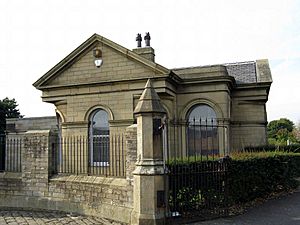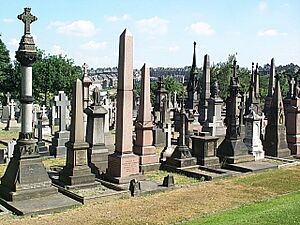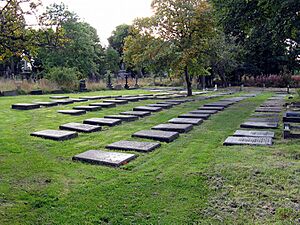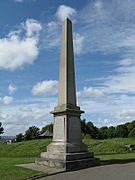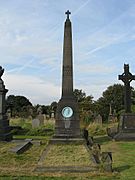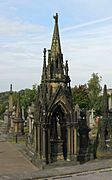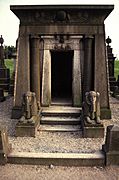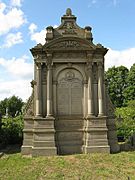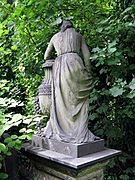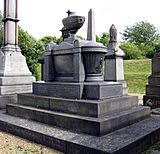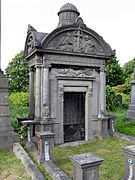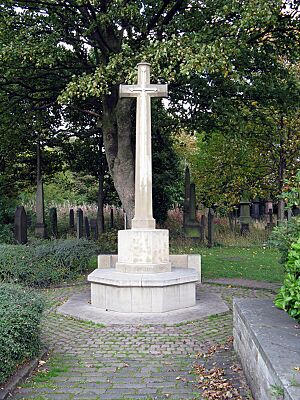Undercliffe Cemetery facts for kids
Quick facts for kids Undercliffe Cemetery |
|
|---|---|
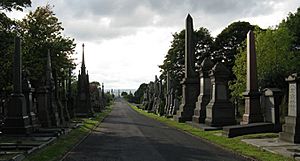 |
|
| Type | Cemetery |
| Location | Undercliffe, Bradford, West Yorkshire |
| Area | 26 acres (10 ha) |
| Elevation | 210 m |
| Created | 1851–54 |
| Designer | William Gay |
| Operated by | The Undercliffe Cemetery Charity |
| Status | Operational |
Undercliffe Cemetery is a special place in Bradford, West Yorkshire, England. It sits on a hillside, offering great views of the city. This cemetery is famous for its amazing old monuments from the Victorian era. Many important local people, like rich factory owners and former mayors, are buried here.
Undercliffe Cemetery is so important that it's listed as a Grade II* historic site. This means it's a very special park and garden in England.
Contents
A Look Back: History of the Cemetery
In the early 1800s, Bradford's textile factories grew very fast. This meant more and more people moved to the city. Soon, there wasn't enough space for homes or for burying people. This became a health problem. So, many older cemeteries had to close down.
To help with this, a group called the 'Bradford Cemetery Company' was started in 1849. Important local people like Titus Salt were part of it. They bought land that used to be a farm in 1851. The company officially began in 1852.
The cemetery was designed between 1851 and 1854. A talented designer named William Gay planned the gardens and layout. An architect named John Dale helped with the buildings. They built two chapels on the main path in 1854.
The western part of the cemetery was officially blessed on August 1, 1854. The cemetery opened to the public on August 21. William Gay became the first person to manage the cemetery's records. In those days, before Bradford had public parks, the cemetery was a popular place for people to take walks.
In 1876, plans to make the cemetery bigger didn't happen. Instead, that land was used for houses. The first two chapels were replaced in 1878 with larger ones.
What Happened Recently
Over time, fewer people were buried at Undercliffe Cemetery. So, the company that ran it closed down in 1977. At first, the local council couldn't afford to take care of it.
In 1980, the land was sold to a property developer. Sadly, the chapels and the gatehouses were torn down. Some gravestones were also removed. But it turned out that the sale was not allowed because the land had been used for burials.
In 1984, after local people campaigned, the Bradford Council bought the cemetery. The area was also made a special 'conservation area'. This means it's protected because of its history. A big project helped clean up the cemetery. A gatehouse from another cemetery was even moved and rebuilt at the southern entrance.
In 1987, a group called 'The Undercliffe Cemetery Charity' took over managing the cemetery. In 1988, English Heritage added the cemetery to its list of special parks. The next year, they made its listing even higher, showing how important it is.
How the Cemetery is Laid Out
The cemetery is high up, about 210 meters (689 feet) above sea level. It covers 26 acres (10 hectares). About 124,000 people are buried here, with around 23,000 marked graves.
A main feature is a long path that runs from east to west. From the western end, you can see great views of Bradford. There's also a small bandstand there. Near the main part of the cemetery, the land slopes down to the northern entrance.
Both entrances have car parks. Only the southern entrance has a lodge building, which is used for the cemetery's office.
Most of the western half of the cemetery is for Anglican burials. The eastern half is for other Christian groups, like Baptists, Methodists, and Quakers. Quaker graves are easy to spot because they have flat, identical stones on the ground.
The northern part of the cemetery was for people who were not baptized or who had been removed from their church. There are also 'company plots' on the southern side. These are large shared graves where many coffins were buried together.
Special Memorials and Burials
The cemetery is home to graves and memorials of many different people. You'll find local business leaders, former mayors, factory workers, and their families here.
Important Listed Monuments
Six of the memorials in the cemetery are so important that they are 'listed buildings'. This means they are protected. Most are in good condition.
- Joseph Smith Obelisk: This is a tall, 30-foot grey stone monument. It honors Joseph Smith, who was a surveyor and helped the cemetery company.
- Mawson Monument: Built in 1889, this monument is for William Mawson, an architect. It's a granite obelisk on a base.
- Swithin Anderton Monument: From 1860, this memorial is for Swithin Anderton, a local judge, and his family.
- Illingworth Mausoleum: Around 1860, this grey granite tomb belongs to the Illingworth family, who owned factories. It looks like an ancient Egyptian tomb.
- Behrens Monument: From 1889, this monument for Sir Jacob Behrens and his family is in a fancy Renaissance style.
- Miles Moulson Monument: Around 1856, this is a sculpture for the Moulson family. Miles Moulson himself was a person who made monuments.
Other Famous People Buried Here
Many other notable people are buried at Undercliffe Cemetery:
- Sir Anthony Gadie (1868–1948): A military officer, Mayor of Bradford, and a Member of Parliament.
- William Gay (1814–1893): The landscape designer and first manager of Undercliffe Cemetery.
- Stafford Heginbotham (1933–1995): A business owner and former Chairman of the Bradford City A.F.C. football club.
- Sir Isaac Holden, bart (1807–1897): An inventor and manufacturer.
- Robert Milligan (1786–1862): Bradford's first mayor and a Member of Parliament.
- Sir Henry Mitchell (1824–1898): He started the Technical School and was also a Mayor.
- Sir Henry Ripley, bart. (1813–1882): An industrialist and Member of Parliament.
- Alfred Angas Scott (1875–1923): A motorcycle designer and the founder of The Scott Motorcycle Company.
War Memorial
Near the car park at the southern entrance, there is a war memorial. It's a 'Cross of Sacrifice' that remembers those who died in the First and Second World War.
Behind this cross, a low stone lists the names of soldiers whose graves couldn't be marked with headstones. In total, 135 soldiers from the Commonwealth are buried here. Many of them were from the Bradford War Hospital.
The Undercliffe Cemetery Conservation Area
After Undercliffe Cemetery opened, some houses were built nearby. These include houses on Undercliffe Lane called Guy's Cliffe, and properties on Undercliffe Old Road. All these buildings now form the Undercliffe Cemetery Conservation Area. This means they are protected because of their historical importance.
The Undercliffe Cemetery Charity
The City of Bradford Metropolitan District Council owns the cemetery. But it is looked after by 'The Undercliffe Cemetery Charity' and its volunteers. It is still an active cemetery, and new burials happen there.
The charity also works to clean about 30 monuments each year. This helps remove dirt and any unwanted drawings.


